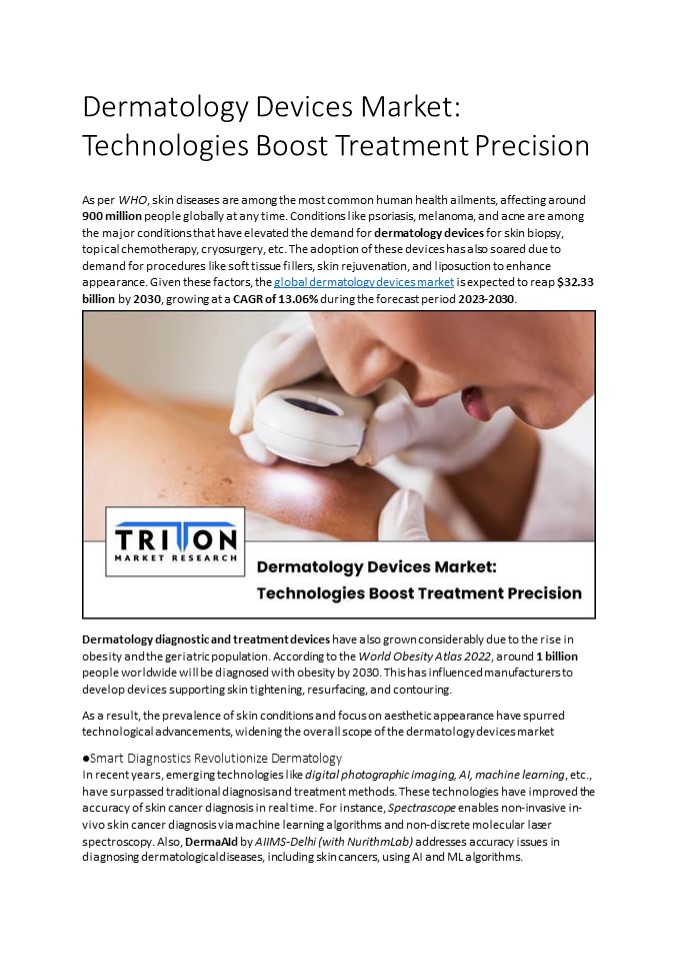Dermatology Devices Market: Technologies Boost Treatment Precision PowerPoint PPT Presentation
Title: Dermatology Devices Market: Technologies Boost Treatment Precision
1
Dermatology Devices Market Technologies Boost
Treatment Precision As per WHO, skin diseases are
among the most common human health ailments,
affecting around 900 million people globally at
any time. Conditions like psoriasis, melanoma,
and acne are among the major conditions that
have elevated the demand for dermatology devices
for skin biopsy, topical chemotherapy,
cryosurgery, etc. The adoption of these devices
has also soared due to demand for procedures like
soft tissue fillers, skin rejuvenation, and
liposuction to enhance appearance. Given these
factors, the global dermatology devices market is
expected to reap 32.33 billion by 2030, growing
at a CAGR of 13.06 during the forecast period
2023-2030.
- Dermatology diagnostic and treatment devices have
also grown considerably due to the rise in
obesity and the geriatric population. According
to the World Obesity Atlas 2022, around 1 billion
people worldwide will be diagnosed with obesity
by 2030. This has influenced manufacturers to
develop devices supporting skin tightening,
resurfacing, and contouring. - As a result, the prevalence of skin conditions
and focus on aesthetic appearance have spurred
technological advancements, widening the overall
scope of the dermatology devices market - Smart Diagnostics Revolutionize Dermatology
- In recent years, emerging technologies like
digital photographic imaging, AI, machine
learning, etc., have surpassed traditional
diagnosis and treatment methods. These
technologies have improved the accuracy of skin
cancer diagnosis in real time. For instance,
Spectrascope enables non-invasive in- vivo skin
cancer diagnosis via machine learning algorithms
and non-discrete molecular laser spectroscopy.
Also, DermaAId by AIIMS-Delhi (with NurithmLab)
addresses accuracy issues in
diagnosing dermatological diseases, including
skin cancers, using AI and ML algorithms.
2
- Besides, on February 2, 2023, Oro Health
announced the launch of its AI-powered
pre-diagnostic triage tool DermSmart to
accurately categorize skin types and common
diseases. - Our report analysis indicates the skin cancer
diagnosis category in terms of diagnostic devices
is estimated to witness the fastest growth at a
CAGR of 12.55 from 2023 to 2030. - Further, more than 9,500 people in the US are
diagnosed with skin cancer daily, as per the
American Academy of Dermatology. Estimates
suggest that the incidence rate of melanoma is
rising rapidly, which has accelerated the demand
for advanced treatment options. In such a
scenario, photodynamic therapy and digital
photography have emerged as ideal solutions that
offer effective and personalized treatment
options to patients. These factors thus widen the
scope of the North American dermatology devices
market, fronted by the United States. - Targeted Treatments with Laser Technology
- From hair removal to skin tightening to tattoo
exclusion, laser technology has gained
significant prominence in aesthetic dermatology
treatments. In this regard, a laser with longer
wavelengths has expanded the range of beauty
treatments, making aesthetic lasers a lucrative
sector for manufacturers to tap. The market is
primarily driven by the CO2 and YAG laser
systems. For instance, CO2 lasers have gained
traction to resurface facial skin by stimulating
collagen, whereas YAG lasers are widely popular
for tattoo removal. - While skin rejuvenation and tattoo removal are
popular treatment device use classes, the hair
removal category is expected to observe the
fastest growth at a CAGR of 14.11 during
2023-2030. - Also, laser leads the treatment device segment in
terms of equipment, attaining a revenue worth - 2369.50 million in 2022. In recent years, laser
devices have materialized as low-risk skin
solutions. Their popularity has fueled strategic
collaborations, creating opportunities for the
dermatology - devices market. For instance, in March 2022, the
Vascular Birthmarks Foundation collaborated with - Candela Medical, Dr. Giacomo Colletti, and
Laserplast to offer pro-bono laser therapies to
more than 30 pre-qualified patients from 13
nations. - Teledermatology Remote Care Spurs Device Demand
- COVID-19-induced virtual healthcare platforms
have also penetrated the field of dermatology. As
the name suggests, teledermatology includes
professional consultation in a remote setting.
Over the years, teledermatology has expanded into
one of the popular specialties, with
dermatoscopes witnessing high demand to
accurately examine morphological structures of
skin lesions. - Based on our assessment, the dermatoscopes
category is expected to witness the fastest
growth in terms of diagnostic equipment at 13.09
of CAGR during the forecast period 2023-2030. - Advanced manufacturing processes such as
reduction in dimensions, digital image analysis,
and integration of AI have enabled digital
dermatoscopes to gain prominence in
teledermoscopy. - Therefore, the rise in teledermatology,
especially to treat highly prevalent conditions
like psoriasis, opens new avenues for the
dermatology devices market. - Minimally Invasive Treatments Broaden Growth
Prospects - In recent years, there has been a considerable
rise in demand for minimally invasive and non-
invasive procedures over traditional surgical
treatment. This is mainly because of advantages
like less pain, reduced scarring, and the fastest
recovery. Moreover, the growing demand for
treatments like skin resurfacing, body
contouring, and wrinkle removal has increased the
demand for minimally
invasive lasers and biopsy devices. Hence, in
retrospect, technologically advanced pain-free
3
treatments are expected to create multiple
opportunities for the dermatology devices
market globally.
FAQs Q1) What regions lead in the dermatology
devices market? North America leads in the
dermatology devices market, attaining revenue
worth 5200.51 million in 2022. Q2) What major
trends shape the dermatology devices
market? Advancements in developing dermatology
devices, growing skin diseases, and rising
preference for cosmetic procedures shape the
dermatology devices market.

